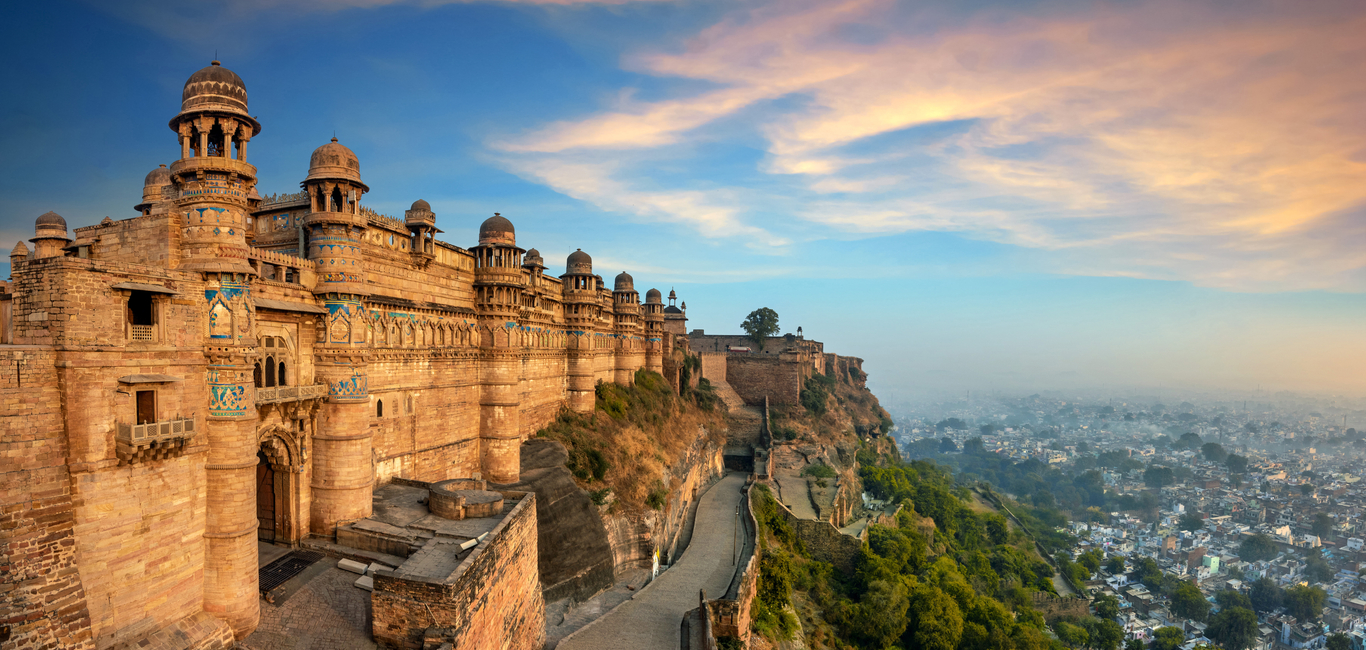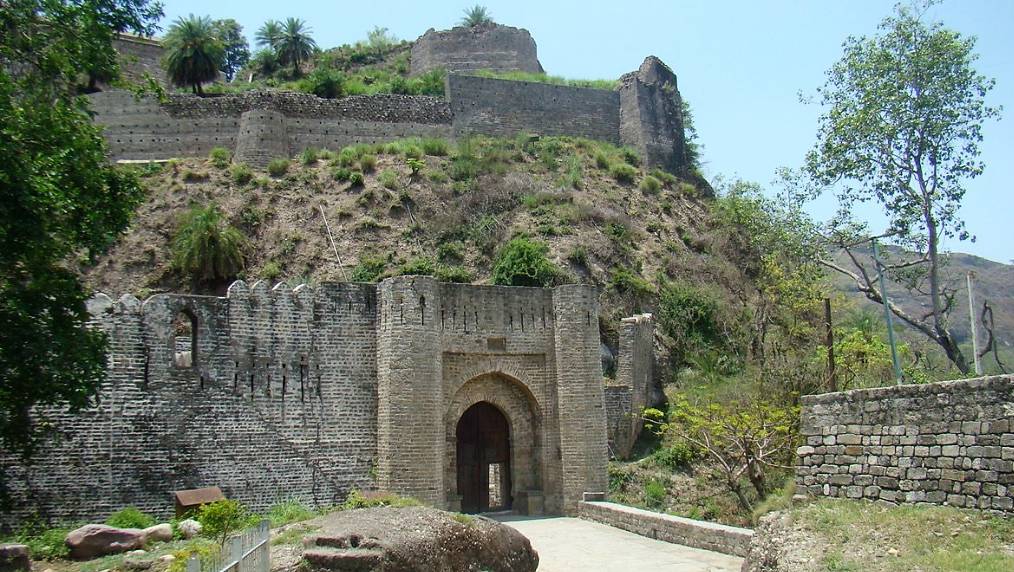Brihadeshwara Temple, Thanjavur
There are many heritage sites in the southern part of our country and Thanjavur city of Tamilnadu is one of the places. Here, you can observe many cultural traditions. The Brihadeshwara Temple that is included in UNESCO’s World Heritage site is also situated in Thanjavur.
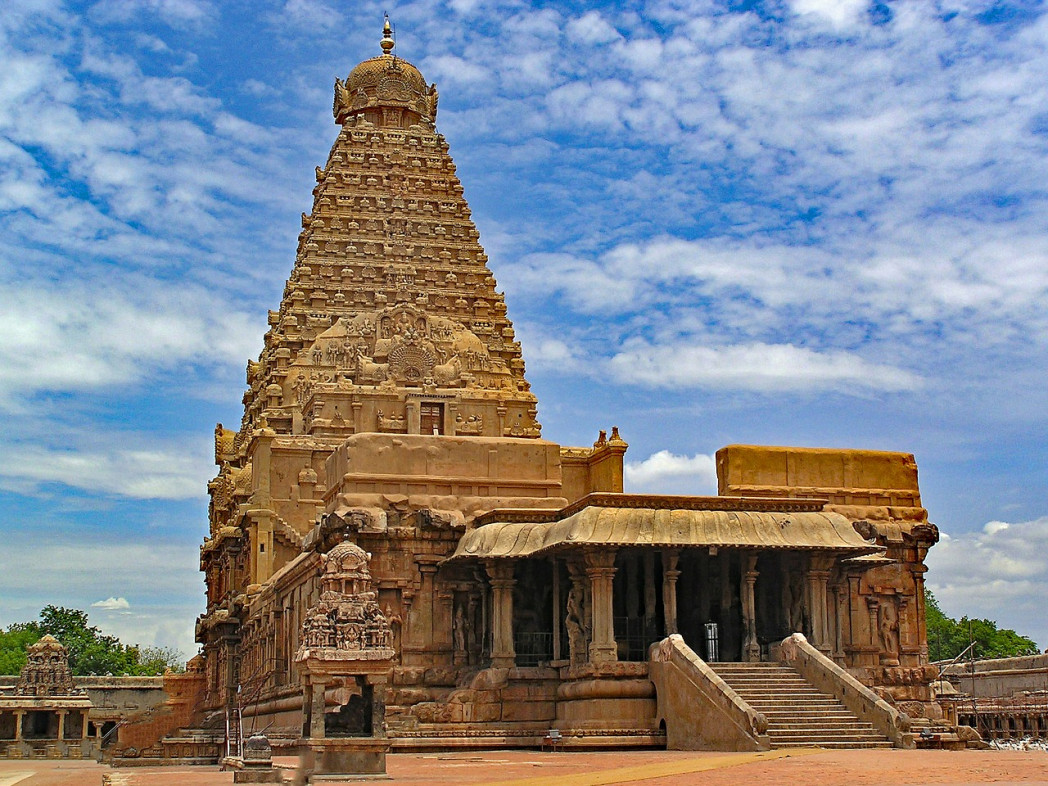 Just by entering here, you will feel like the old period of history has halted and if you are traveling by road then the clean roads will make you reach there soon and you will be fascinated by the archaeological significance. Thanjavur which is also known as Thanjavur is the administrative headquarters of Thanjavur district. The town is located in the Kaveri Delta that is at the distance of 300 from the Chennai city. The town was an initial capital of Chola from the ninth to the eleventh century and during the Vijayanagara Empire, Maratha and British Reign, it was equally important. If you are trying to travel there, then take enough time for the tour so that you can travel to the town and as well as you can travel to many more tourist places. There are good facilities of government as well as private hotels to stay for tourists and pilgrims near their visiting destinations. The museum is located in the Library building to reveal the importance of the Library to the Public. This Museum is small but organized into sections highlighting ancient Manuscripts, Illustrated Manuscripts, Printed copies of the Original Drawings, Atlases, Thanjavur- style Paper Paintings, Canvass Paintings, Wooden Paintings, Glass paintings, Portraits of the Thanjavur Maratha kings, and the Physiognomy charts of Charles Le-Brun. These materials give an idea of the total variety in the vast collection within the Library.
Just by entering here, you will feel like the old period of history has halted and if you are traveling by road then the clean roads will make you reach there soon and you will be fascinated by the archaeological significance. Thanjavur which is also known as Thanjavur is the administrative headquarters of Thanjavur district. The town is located in the Kaveri Delta that is at the distance of 300 from the Chennai city. The town was an initial capital of Chola from the ninth to the eleventh century and during the Vijayanagara Empire, Maratha and British Reign, it was equally important. If you are trying to travel there, then take enough time for the tour so that you can travel to the town and as well as you can travel to many more tourist places. There are good facilities of government as well as private hotels to stay for tourists and pilgrims near their visiting destinations. The museum is located in the Library building to reveal the importance of the Library to the Public. This Museum is small but organized into sections highlighting ancient Manuscripts, Illustrated Manuscripts, Printed copies of the Original Drawings, Atlases, Thanjavur- style Paper Paintings, Canvass Paintings, Wooden Paintings, Glass paintings, Portraits of the Thanjavur Maratha kings, and the Physiognomy charts of Charles Le-Brun. These materials give an idea of the total variety in the vast collection within the Library.
View from the Bail Tower
If you will see the Bail Tower then you will notice that it makes the scene of some action film and sculptures that are made of brass and copper are also some place of attraction. The dome-shaped tower of the palace is the symbol of this town which is also a proof of best architecture. When the giant bell of this tower is ring then the whole town could hear it. The tower is made like this so that Kings could see the whole town. From this, we can learn that even in today’s world Dancing Towers, Bell Shape Towers and Tree Shape towers are made.
Amazing Thanjavur Paintings
Thanjavur painting is a classical South Indian painting style, which was exposed from the town of Thanjavur and spread across the Tamil country. The art form draws its instant resources and inspiration from way back about 1600 AD, a period when the Nayakas of Thanjavur under the rule of the Vijayanagara Empire encouraged art, classical dance and music as well as literature, both in Telugu and Tamil and painting of mainly Hindu religious subjects in temples. In Thanjavur’s paintings, one can see the power of Vijayanagara, Maratha and even European or Company styles of painting.
Episodes from Hindu Puranas, Sthala-Puranas and other religious texts were imagined, sketched or traced and painted with the main figure placed in the central section of the picture surrounded by several supplementary figures, themes, and subjects. There are also many instances when Jain, Sikh, Muslim, other religious and even secular subjects were depicted in Thanjavur paintings.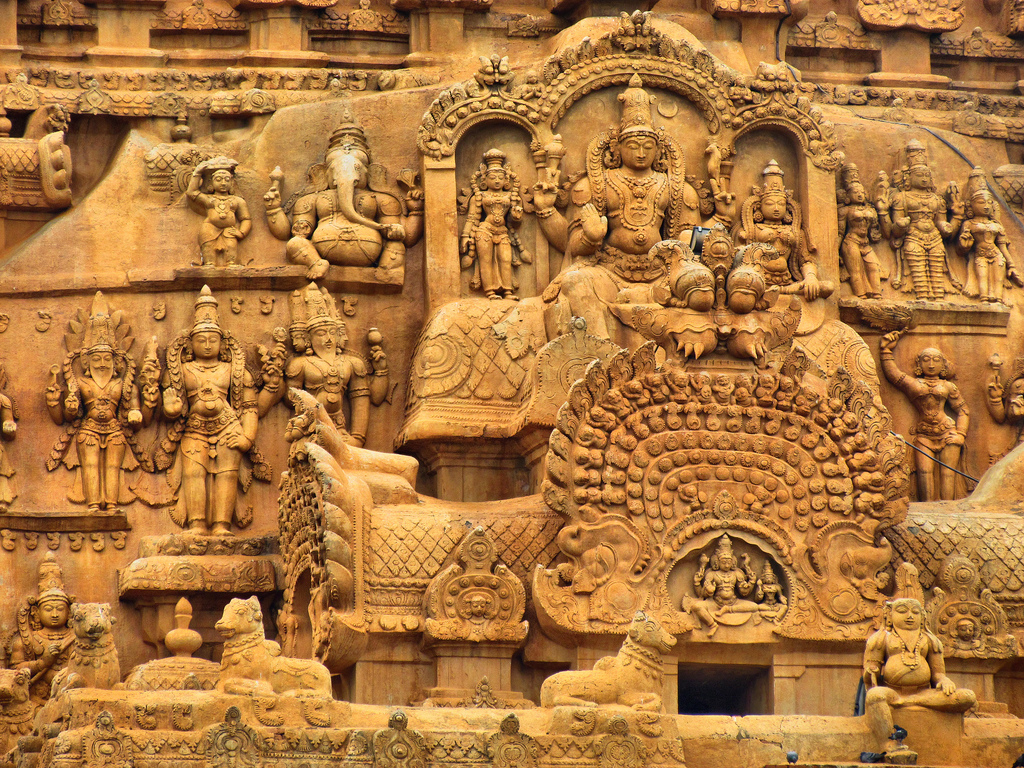
Asia Oldest Library
Thanjavur Maharaja Serfoji’s Sarasvati Mahal Library is one of the oldest libraries in Asia and has on display a rare collection of Palm leaf manuscripts and paper written in Tamil, Telugu, Marathi, Hindi and a few other languages native to India. The collection comprises well over 49,000 volumes, though only a tiny fraction of these are on display. The library has a complete catalog of holdings, which is being made available online. Since 1918 the Saraswathi Mahal Library has been a possession of the state of Tamil Nadu. Its official name of the Library was changed to “The Thanjavur Maharaja Serfoji’s Sarasvati Mahal Library” in honor of the great royal Marathan patron. The library is open to the public; it also supports efforts to publish rare manuscripts from the collection, as well as ensuring all volumes are preserved on microfilm. The Library has installed computers in 1998 for the Computerization of Library activities. As a first phase, the Library catalogs are being stored in the Computer for easy information retrieval. It is also proposed to digitalize the manuscripts of this Library shortly.
Venkateswara Temple, Tirumala
From the crest of the picturesque Saptagiri hill radiates the towering presence of Sri Venkateswara, the god of the Seven Hills at Tirupati. It is India’s most prosperous temple and its deity, the most powerful to grant the wishes of its devotees.
To marvel at the power of faith, there’s no better shrine than that of Lord Venkateswara, an awesome avatar of Vishnu at Tirumala atop the Saptagiri Hills (Seven Hills). India’s premier pilgrim destination in Andhra Pradesh receives over 1 lakh pilgrims daily. It is one of the world’s richest religious bodies, earning 22.5 lakh daily in cash offerings. The temple’s prosperity is evident around the hill of Tirumala (Vishnu’s name) all the way down to the town of Tirupati.
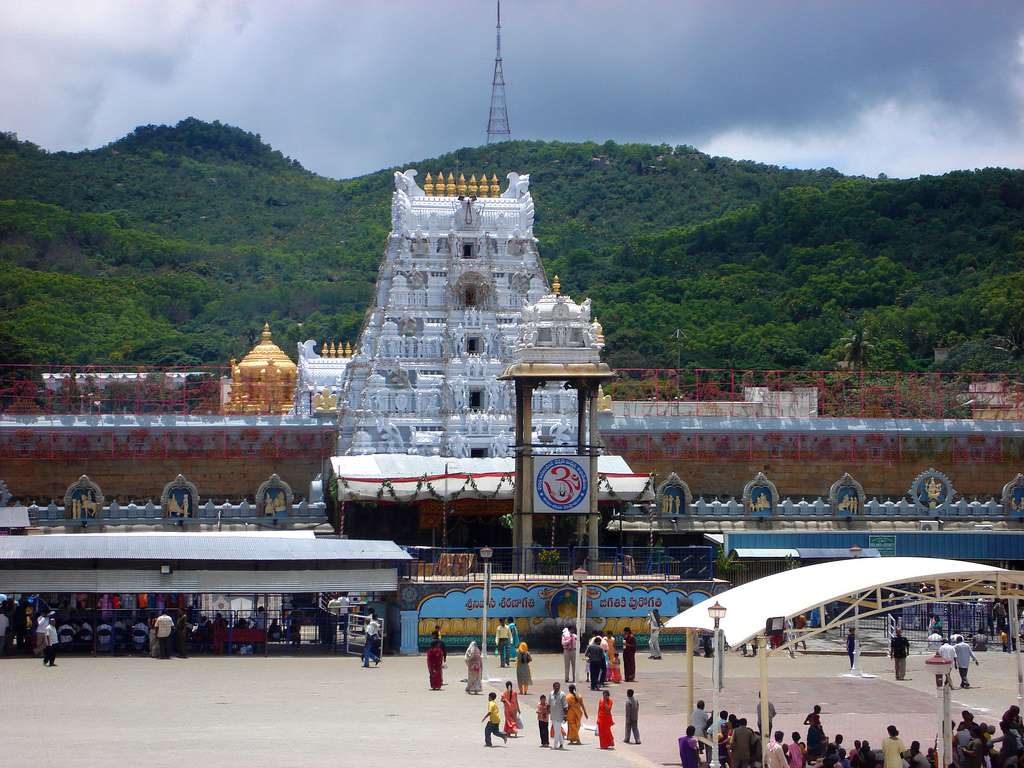 Temple Deity – Sri Venkateswara
Temple Deity – Sri Venkateswara
Given the crowds, it’s a lucky day if a darshan of Lord Balaji lasts longer than a nanosecond before you’re asked to move on by temple ushers. When the priests draw back the curtains for the reveal, the rumble of prayers reaches a crescendo from the throng. You behold the vision of a tall and dark frame of the 8-ft deity, lit by the jewel lights of the lamps and burning camphor, in divine regalia. Unlike other reclining forms of Vishnu, Venkateswara stands draped in sweeping silk robes and necklaces of gold and glittering diamonds, a large emerald ornament, sparkling rubies, and a diamond-encrusted crown. His eyes are hidden by a large white and red tirunamam mark that is the symbol worn by Vaishnavite deities in the south on their foreheads. His right palm is open and bestowing, while the left rests on his hip. His two other arms hold aloft the Vaishnavite insignias – the conch and discus, covered in gold.
Temple History
History dates the temple structure and Tirumala hills to be almost 2000 years old. Prehistoric Tamil scriptures mention the temple and the hills, with references to the deity or the lord of Vengadam or Venkata. Tirumala is part of the green Saptagiri Hill range (Seven Hills). The temple is located on top of Tirumala, the last and seventh hill. Vaishnavite historians of the South claim that the temple was established in the 12th century by the saint Ramanuja. Active temple construction began from the time of King Krishnadevaraya, from the 14th century onwards. Further kings of the dynasty added to the temple building, with individual Commemorative gopurams. In the late 1950s, the vimana or the main tower of the temple was encrusted in gold.
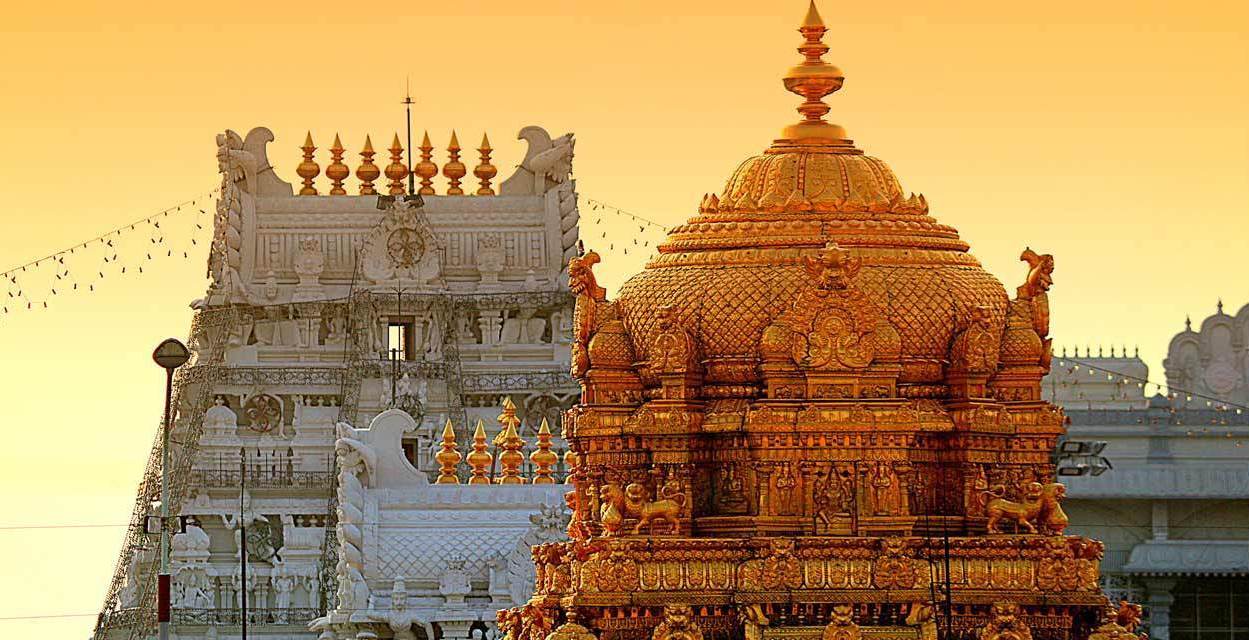 Style & Architecture
Style & Architecture
The Tirumala temple and smaller temples and shrines around Tirupati follow traditional styles of Dravidian architecture that includes large and wide praharams or perimeters surrounding the main shrine with mandapams named after the kings associated with the temple like the Krishnaraya mantapam or Tirumalaraya mantapam and open spaces and interesting sculptures of Garuda, Vishnu’s mount near the flag post. Given the crowds, it needs a keen eye to spot the many sculptures and architectural features. A walk around the temple perimeter in the early morning or evening when it’s not too hot is the best time to look at those.
Special Features
The temple structures reflect the patrons from various faiths who have been moved by the power of the deity. Note the idol of a Muslim overlord near the dwajasthamba (flagpost) who is said to have protected the temple from destruction. The temple museum in Tirumala is a sparkling clean building that houses paintings, sculptures, and photographs related to the history of the Sri Venkateswara Swamy Temple (8 am-8 pm). Tulabaram are offerings made on a giant iron scale and devotees offer rice, wheat, fruits or sugar equal to their body weight to the god at the Tirumalaraya mantapam. A quick stop is enough to witness the geological wonder, Shila Thoranam, a rock formation located in a park close to the temple (6 am-5 pm).
Temple Festival
The Brahmotsavam is a grand festival held annually in October. According to lore the first puja and festive procession for Lord Venkateswara were led by the god Brahma and hence the festival bears his name. The nine-day festival involves grand processions of heavily bejeweled idols of Balaji and his consorts. The idols are brought out on a decorated vimana each day on various mounts. A rath yatra is held on a ninth day to round off the festivities. While darshan queues during the festive time can run up to several kilometers, thanks to the efficient Tirumala Tirupati Devasthanam a sense of order prevails. Sep-Oct; for dates and timings check TTD (www.tirumala.org)
Sabarimala Temple, Kerala
More than 30 million pilgrims visit the temple in Sabarimala annually, making it the largest in India and the second largest in the world, after the Hajj Pilgrimage of Mecca in Saudi Arabia. Located inside the Periyar Tiger Reserve, in the Pathanamthitta district of Kerala, Sabarimala is a temple tow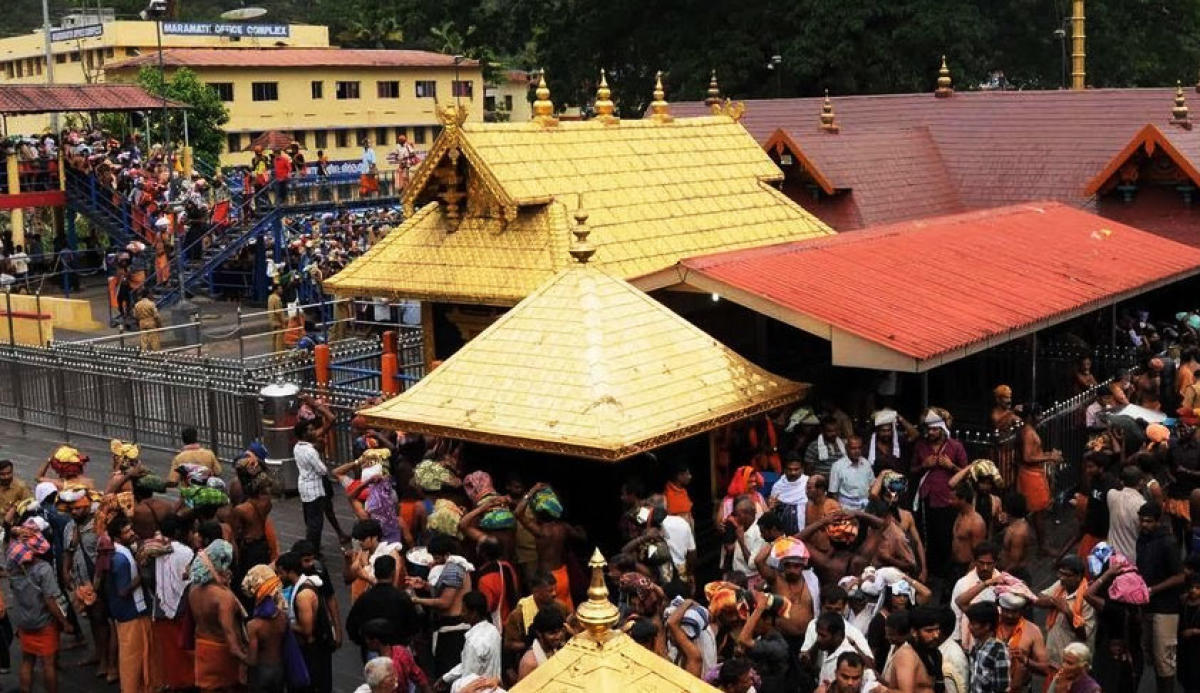 n on the bank of the River Pampa.
n on the bank of the River Pampa.
Named after the mythological character, Sabarimala shelters the famous Ayyapa temple. The temple is also known as Dharma Sashta and is believed to be the son of Shiva and Mohini, the feminine incarnation of Lord Vishnu. People believe that Vishnu’s incarnate, Parasurama, placed the Ayyappa Idol at the top of the mountain.
One can notice that the traditions of Sabarimala are a blend of Shaivism, Shaktism, Vaishnavism, and other Sramana traditions. Women of age 12-50 years, during an active menstrual cycle, weren’t allowed inside the temple until the supreme court overturned the restriction on 28th September 2018.
The temple is situated amidst eighteen hills and dense forest surrounding the temple, which is known as Poongavanam. People trek up the mountains from Plapalli, proceeding to Aangaamuzhi, and then to Muzhiyaar and finally to Sabarigiri road. The temple is open on the first five days of each Malayalam month with it being most crowded during Mandalapooja, Makaravilakku or Makar Sankranti.
Sabarimala Pilgrimage
The world-famous Sabarimala pilgrimage is undertaken by thousands of ardent devotees every year. A strict-41 day fast is observed before the pilgrimage, which is believed to be a cleanser for the mind, body, and soul. The devotees follow a Lacto-vegetarian diet and practice celibacy and teetotalism.
They also do not cut their hair or nails during this period, allowing them to grow. Their attire is composed of simple black or saffron garments, and they wear a special mala or chain made of Rudraksha beads. The devotees are expected to lead an altruistic lifestyle by helping others and doing service in the name of their Lord Ayyappan.
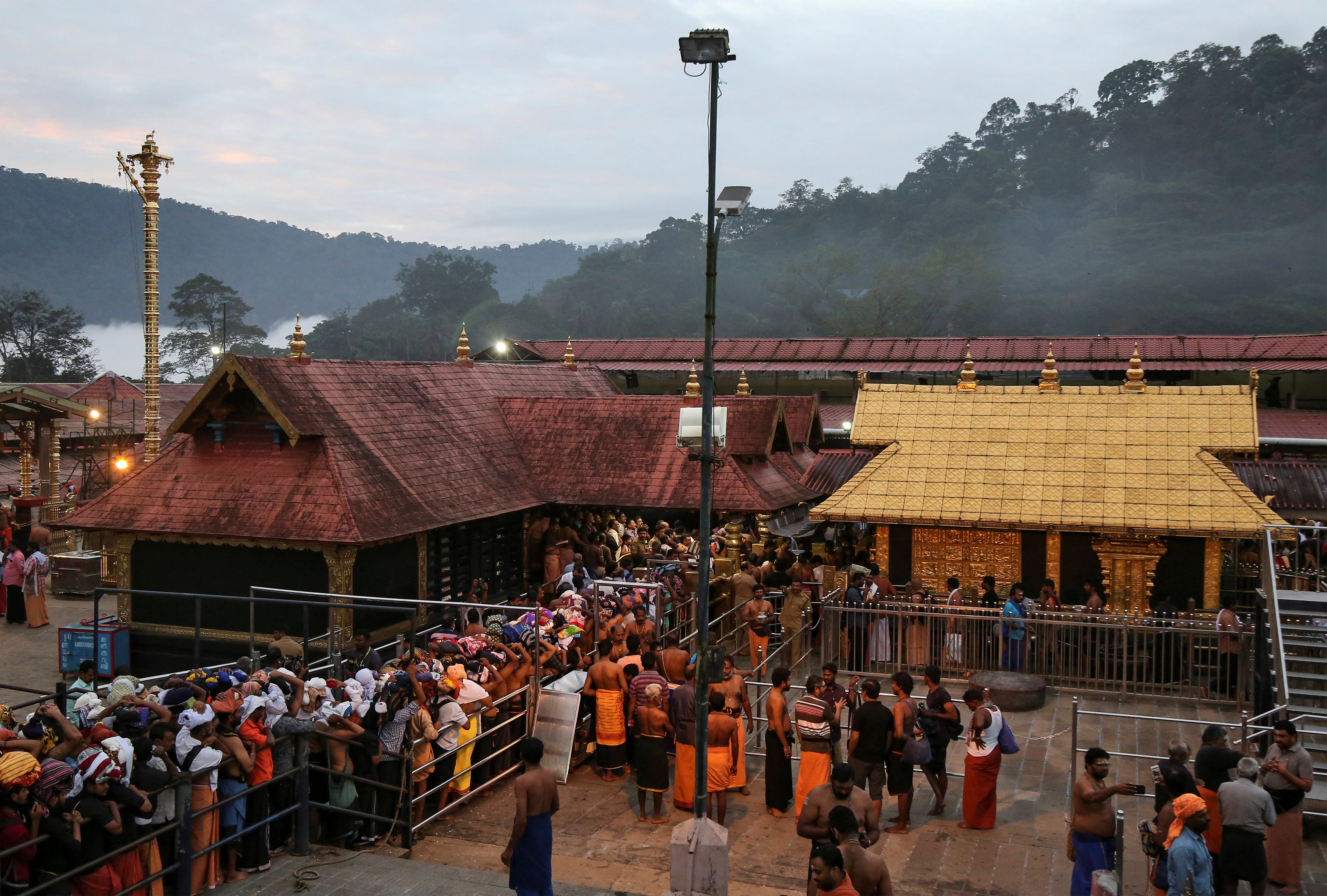
After the fast period, the devotees follow the difficult path through Erumely to reach the Pamba river, or else they arrive by vehicles. They then begin their long climb from the Neeli Mala to Sabari Mala, the abode of Lord Ayyappan.
Women between the ages of 10 to 50 are not allowed on Sabarimala, following the 1991 ruling by the Kerala High Court. This is now up for contention yet again and has been receiving widespread coverage in the media over the last year.
The Temple “Dharma Sashta”
The Ayyappa Temple is one of the very few Hindu temples in India that are open to all faiths and emphasizes on secularism and communal harmony. All men are seen equal before the Lord, irrespective of their caste, creed or race and hence all people visiting the temple refer to each other as “Ayyappa Swami”.
The temple is considered to be laid out according to the Lord’s wishes and hence one can see that Goddess Malikappurathamma is placed left to the main Sannidhanam and the Lord’s aides, Vavar and Kadutha stand at the foot of the 18 Holy steps (Pathinettu Thrippadi) that leads to the main sanctum.
The temple was rebuilt after a massive fire in 1950 and stands on a plateau surrounded by mountains and valleys below. The sanctum sanctorum has a copper-plated roof with golden finials, two mandapams, the ‘Kodimaram’ or the flagstaff and the Belikalpura which houses the altar.
The Ayyappa idol which was initially carved out of stone is presently made out of Panchaloha, an amalgamation of five metals and stands one and a half feet tall.
Virupaksha Temple, Hampi
This temple is located on the south bank of the river Tungabadra, just next to where the local bus drops you. This area, in general, has been an important pilgrimage center for the worshipers of Lord Shiva. Virupaksha temple is equally sorted after by the tourists and pilgrims. The annual festivals attract huge crowds of both types.
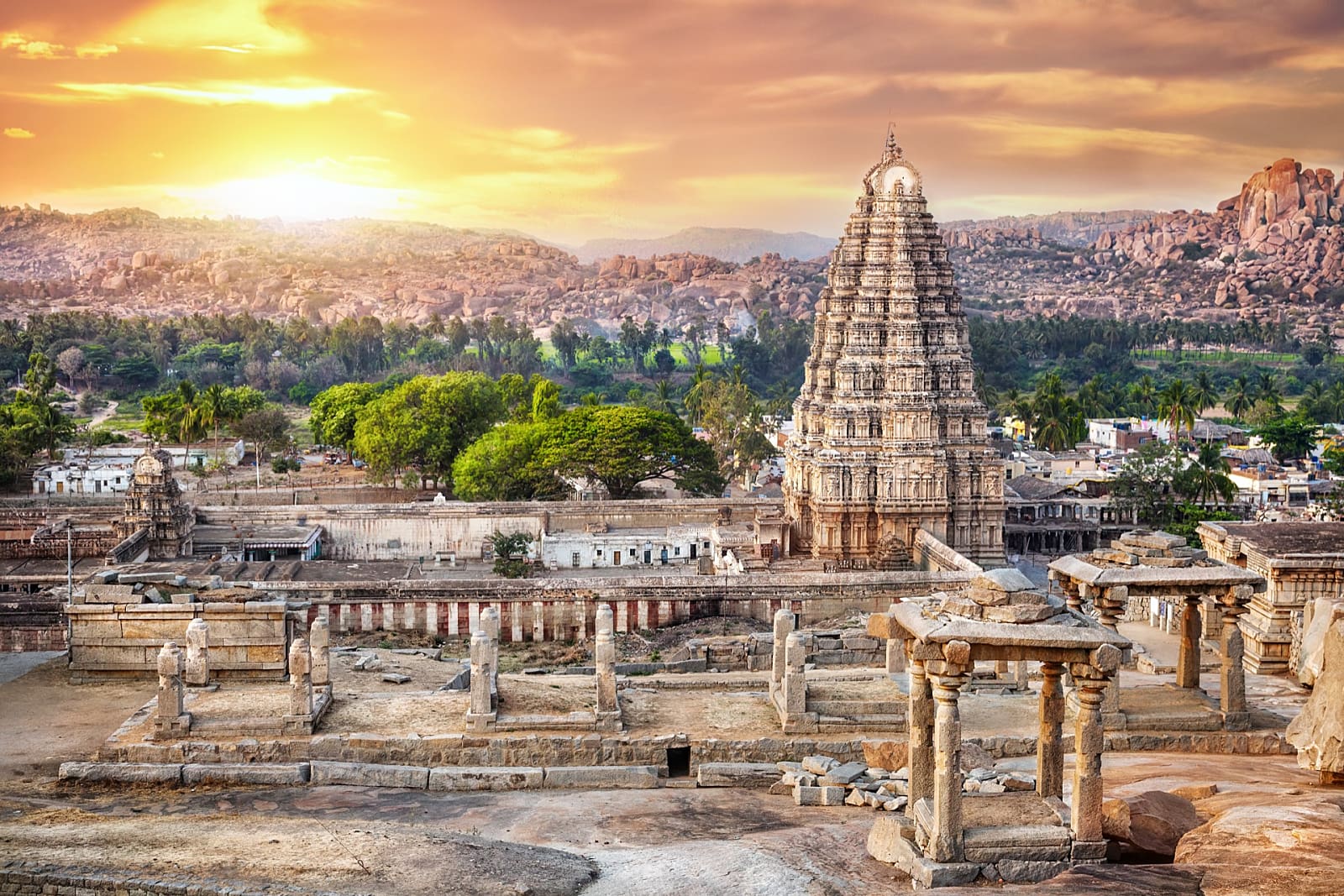 The very origin of Hampi’s history as a sacred place revolves around the myths associated with this temple. It believed that this temple has been functioning uninterruptedly ever since its inception in the 7th century AD. That makes this one of the oldest functioning temples in India.
The very origin of Hampi’s history as a sacred place revolves around the myths associated with this temple. It believed that this temple has been functioning uninterruptedly ever since its inception in the 7th century AD. That makes this one of the oldest functioning temples in India.
The original worship place was only a few separate humble shrines (believed to be as old as 7th century) housing the image of the god and the goddesses. Over the centuries the temple gradually expanded into a sprawling complex with many sub-shrines, pillared halls, flag posts, lamp posts, towering gateways, and even a large temple kitchen. You access the temples main entrance tower through the chariot street in front now popularly called the Hampi Bazaar.
This east facing giant tower (Gopura) leads you to the first courtyard of the temple complex. This pastel painted 9 storied towers with a pair of cow horn like projections on top is the most prominent landmark in Hampi. The lower two tiers of the tower are made of decorated stonework.
The progressively diminishing superstructure is made with brick and mortar. All around the exterior of the first tier spots many interesting stucco figures. You may get to some distance from the base of the tower to see all of them. For example, the erotic figures of the amorous couples located on the south side of the tower. Such icons connected with fertility rites are considered auspicious on the philosophical ground. You can view them from the southward going alley (towards the post office) from this entrance to the tower. These stucco figures are located at the bottom row of the stucco figures.
The main temple is east facing and has two large courtyards, one leading to the other. You directly enter into the first courtyard through the tower mentioned above. This courtyard mainly houses a pillared hall called 100-column hall at the far left corner, Kalyanamantapa at the far right corner, administrative offices, the ticket counter, a police outpost, and even an old well. A kitchen complex projects out of the compound overlapping the two courts at the south wall. A narrow passage on the wall of the 100 pillared halls gives access to the kitchen. A water channel system connected to the nearby river is built into the floor of the kitchen complex. You can see the remains of its feeding channels outside the southwest corner of the temple corner.
Just next to your left immediately after you have entered, you can see the unusual triple-headed Nandi (bull statue). Behind this, the wall is painted with a large map of Hampi with the main attractions marked.
Towards you are right close to the tower is a police outpost. Foreign tourists are requested to register their details here. This is a simple process of entering your names and other details in the register book kept at this office. You may register it at any time and not a prerequisite to enter the temple.
Further forward (east) towards the second tower you would find the ticket counter and the shoe safekeeping (1 rupee per pair) booth and a souvenir stall with a good collection of books & maps on Hampi. The three-storied towers built in 1510 AD is known after its patron, Krishadeva Raya, one of the famous kings of the empire.
From the ticket counter close to this tower you can buy the entry ticket (Rs5), camera ticket (Rs50) and pay the video camera fee (Rs 500)
The tower gives access to the inner court. On entering this you would meet an important inmate the temple, the little naughty elephant. Give a one-rupee coin (the elephant takes it from you with its trunk) and you can get a smooch on the head, treated as a blessing.
In the middle of the court along the axis facing the main shrine are a lamppost, the Balipitas(sacred platforms), a flag post and a whitewashed pavilion in which two Nandi(bull)status are positioned.
All around this open area are the pillared cloisters leaving gaps at the north, south and east edges for a series of sub-shrines. The facing portion of the cloister is lined with a row of decorated pillars. The lion figure carved on the base of each of these pillars seems supporting the slender upper portions. Close looks at each of the pillars reveal interesting figures of animals and other life scenes.
Pair of elephant balustrades in the middle of the row gives access to the top of the cloister platform. The western end of the south cloister spots a rectangular opening on the floor. A shrine is located underground. A Nandi is positioned near the opening. Near to it is a huge stone urn with decorations. Towards the end, you can see a pair of metal bells and a large leather-clad percussion instrument.
The most striking feature of this court is the central pillared hall known as the Ranga Mandapa added to the temple complex in 1510 AD by Krishadeva Raya.
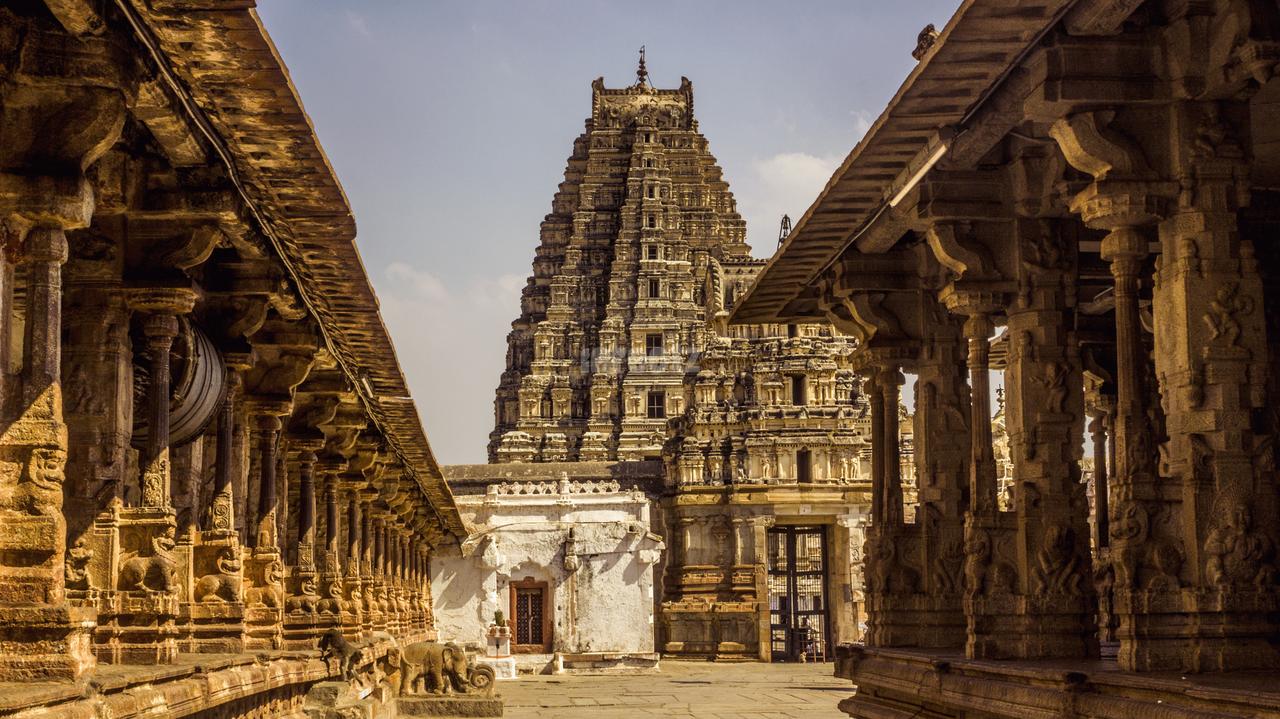 Two mythical lions like creatures from the balustrade for the entrance to this elevated open pavilion. As you enter the pavilion on your right is an inscribed plaque with Nandi image on top probably explains the royal patronage the temple enjoyed. This hall with 5 aisles and 38 pillars is used for temple rituals including the marriage ceremonies. The highlights include rows of pillars shaped with rampant lion-like mythical creatures (Yalis) standing on aquatic creatures (Makara or Crocodiles). Warriors seem to ride on these ferocious-looking creatures.
Two mythical lions like creatures from the balustrade for the entrance to this elevated open pavilion. As you enter the pavilion on your right is an inscribed plaque with Nandi image on top probably explains the royal patronage the temple enjoyed. This hall with 5 aisles and 38 pillars is used for temple rituals including the marriage ceremonies. The highlights include rows of pillars shaped with rampant lion-like mythical creatures (Yalis) standing on aquatic creatures (Makara or Crocodiles). Warriors seem to ride on these ferocious-looking creatures.
The mural panel on the central portion of the hall is one of the few remains of this form of Vijayanagara art. Most of it is based on godly themes except the one at the eastern end.
Here the founder sage of the empire, Vidaranaya, is portrayed moving in a procession.
Further west, beyond a small inner hall, is the sanctum sanctorum of Lord Virupaksha. Two 4 armed guardian deities, about 8 feet tall, stand on either side of the entrance to the inner hall. The ceiling of this inner hall is decorated with an open lotus motif
The sanctum contains the idol of lord Virupaksha in the form of a Linga (A phallus image). A corridor surrounds the sanctum.
The two narrow porches on either side of the inner hall can be used to get in and out of the main shrine.
Surrounding these principal shrines are the shrines of Virupakshas consort and other deities.
The most important of the sub-shrines are that of Goddess Pampa and Bhuvaneswari, consorts of Lord Shiva, towards the north of the main shrine. These shrines are much older than the rest of the grandiose structures in the compound. The short circular pillars and the doorways and the ceiling are richly carved. A bit east along the cloister, you can spot a flight of leading to an underground chamber. This contains the shrine of Pataleswara, a form of Lord Shiva. Further east is the shrine of the planetary deities. Images of the nine planetary deities (Nava Grahas) are arranged on an elevated platform.
Photography is not permitted inside the sanctum area.
Behind the main sanctum, a flight of steps leads to the rear exit of the temple complex. Just before the exit on the right side, you would find a dark chamber with a slit on the wall. The sunray pass through this slit forms an inverted shadow of the main tower on the wall, a kind of pinhole camera effect created with stonework.
Further up the stairs, you would come out of the temple campus. Nearby is a shrine dedicated to the founder sage Vidyaranya. Here also you can see the pinhole inverted shadows in a small shrine chamber. Usually, someone operating the show would demonstrate it for you expecting a couple of rupees tip.
Most of this locality is the residential area of the temple priests. If you trace a narrow path along the outer wall towards the south, you’ll reach a small but interesting pond with pillared halls all around it. The shrines here are not under worship and the area somewhat deserted. You can see several crisscrossing aqueduct systems mentioned earlier. Thick banana plantations and shrubs surround the location.
Back to the main temple, the giant north tower, called Kangiri Gopura, near the main sanctum leads to the temples sacred pond, the Manmantha Tank and a series of shrines.
Altogether you need at least 1 hour to see this temple complex. If you feel so hire a guide who would bump on you as you approach the main entrance tower (pay Rs50).
You can witness the daily temple rituals and ceremonies in the mornings and evenings. Temple opens before the sunrise and closes in the night. Usually, the sanctum is closed at noon. So entry into the campus may not be possible then.
Vijaya Vitthala Temple
The Vittala Temple in Hampi is an ancient structure, which is well known for its architecture and unmatched craftsmanship. The monument is seen as one of the largest and famed structures in the group of monuments in Hampi. The temple is located in the northeastern part of Hampi near the banks of the river Tungabhadra.
This temple has some beautiful stone structures – like the stone chariot which cannot be described in words and the interesting musical pillars. The temple is a major draw amongst the tourists who come from across the globe to witness the once-glorious Vijayanagara capital, which lies in ruins now.
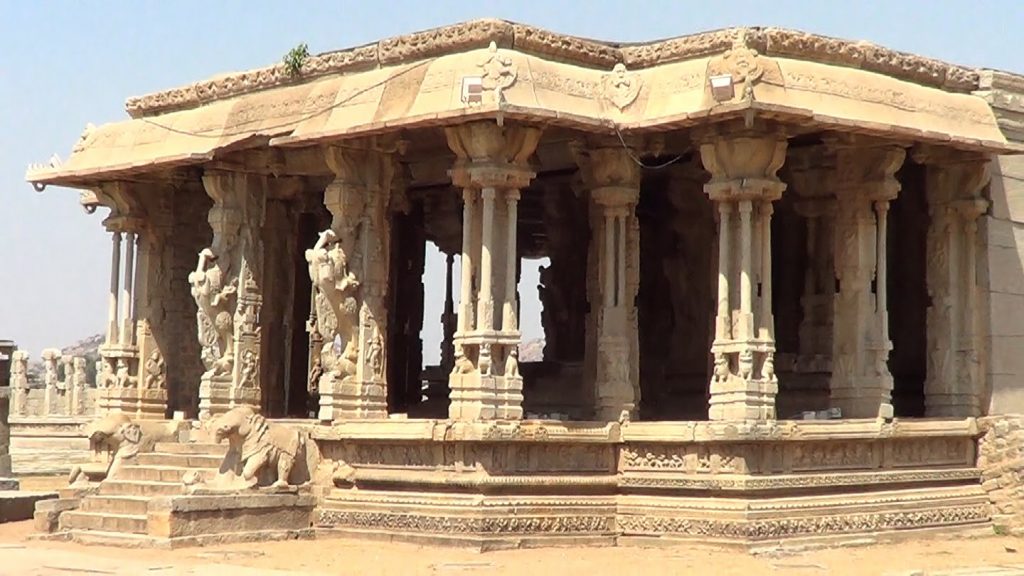 About The Temple
About The Temple
The structure was built during the rule of Devaraya II, who was one of the rulers of the Vijayanagara Empire. The structure was built in the 15th century. Many portions of the temple were expanded and enhanced by Krishnadevaraya, who was the most famous ruler of the Vijayanagara dynasty.
The temple is also called Vijaya Vittala Temple and is dedicated to Vittala, an incarnation of Lord Vishnu. According to legends, the temple was built as an abode for Lord Vishnu in his Vittala form, but he found the temple to be a very grand one for him and hence he is said to have returned to live in his own humble home at Pandharpur.
The Architectural Marvel
The Vittala temple is assumed to be the grandest of all the temples and monuments at Hampi. The temple showcases the immense creativity and architectural expertise, which was possessed by the sculptors and artisans of the Vijayanagara empire. The temple is built in the Dravidian style of architecture, which speaks volumes about the grandeur of the south Indian temple architecture, with elaborate carvings that are unmatched to the other structures in the town.
The main shrine originally had an enclosed Mantapa and an open Mantapa or hall was added to the structure in the year 1554 AD. The temple is spread across a large area with high compound walls and three tall gopurams. The complex also has many halls, shrines, and pavilions within its circumference. Among the structures, the Devi shrine, Maha Mantapa or the main hall, Ranga Mantapa, Kalyana Mantapa, Utsava Mantapa, and the much famed Stone Chariot are the notable ones. The Stone Chariot, which stands tall in the courtyard of the temple, is one of the most stunning architectural wonders and is also one of the three famous stone chariots in the country. The other two chariots are located in Konark and Mahabalipuram.
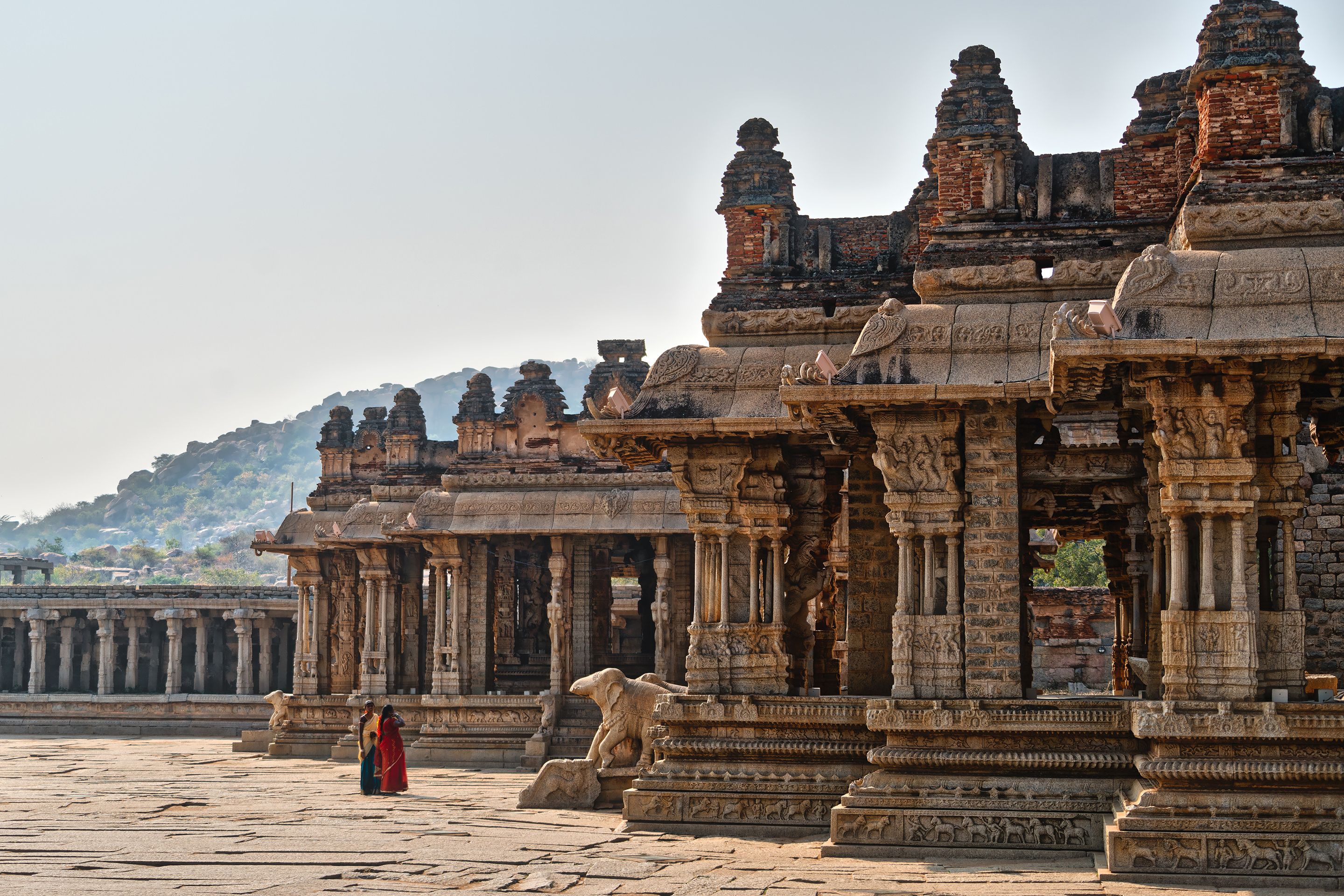 The stone chariot is a shrine which was designed in the shape of a chariot. This chariot shrine is dedicated to Garuda – the carrier of Lord Vishnu and one can find an image of Garuda housed in its sanctum.
The stone chariot is a shrine which was designed in the shape of a chariot. This chariot shrine is dedicated to Garuda – the carrier of Lord Vishnu and one can find an image of Garuda housed in its sanctum.
The Musical Pillars Of The Ranga Mantapa
The large Ranga Mantapa is well known for its 56 musical pillars. These pillars are also known as SaReGaMa pillars, which are attributed to the musical notes emerging out of them. The musical notes can be heard when the pillars are gently tapped. One can find a set of main pillars and also several smaller ones at the mantapa.
Each pillar provides support to the ceiling of the mantapa, and the main pillars are designed in the manner of musical instruments. Every main pillar is wrapped by 7 minor pillars and these minor pillars emit different musical notes. Every note coming out of these pillars vary in their sound quality and also change as per the percussion, string or wind instrument being played.


